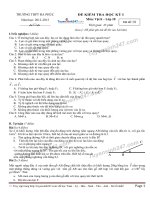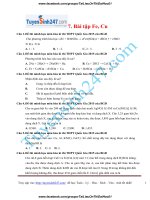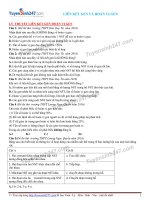Bài tập phép toán số học trên máy tính (kỹ thuật máy tính) (Có lời giải chi tiết)
Bạn đang xem bản rút gọn của tài liệu. Xem và tải ngay bản đầy đủ của tài liệu tại đây (328.16 KB, 16 trang )
Exercise 1: Let’s look in more detail at division. We will use the octal numbers in the
following table.
A
40
25
A
B
B
21
44
1. Calculate A divided by B using the hardware described in Figure 1 and the algorithm
shown in Figure 2. You should show the contents of each register on each step. Assume A
and B are unsigned 6-bit integers.-
Figure 2.
Figure 1.
2. Calculate A divided by B using the hardware described in Figure 3. You should show
the contents of each register on each step. Assume A and B are unsigned 6-bit integers.
Figure 3.
Exercise 2: The following table shows decimal numbers
b
-1609.5
-938.8125
1. Write down the binary representation of the decimal number, assuming the IEEE
754 single precision format.
2.
Write down the binary representation of the decimal number, assuming the IEEE
754 double precision format.
Exercise 3: Let’s look in more detail at division. We will use the decimal numbers in the
following table.
A
13
30
A
B
B
20
9
1. Calculate A divided by B using the hardware described in Figure 1 and the algorithm
shown in Figure 2. You should show the contents of each register on each step. Assume A
and B are unsigned 6-bit integers.
2. Calculate A divided by B using the hardware described in Figure 3. You should show
the contents of each register on each step. Assume A and B are unsigned 6-bit integers.
Exercise 4: The following table shows decimal numbers
b
5.00736125 x 105
-2.691650390625 x 10-2
3. Write down the binary representation of the decimal number, assuming the IEEE
754 single precision format.
4.
Write down the binary representation of the decimal number, assuming the IEEE
754 double precision format.
Exercise 5: The following table shows bit patterns expressed in hexademical notation.
0x24A60004
b
0xAFBF0000
1. What decimal number does the bit pattern represent if it is a two’s complement
integer? An unsigned integer?
2. If this bit pattern is placed into the Instruction Register, what MIPS instruction
will be executed?
3. What decimal number does the bit pattern represent if it is a floating point
number? Use the IEEE 754 standard.
Exercise 6:
The following table shows pairs of decimal numbers
1. Calculate the sum of A and B by hand, assuming that we keep 11 bits of
significand and 5 bits of the exponent. (Rounding rule: add 1 if the bits to the
right of the desired point is larger or equal to 100(2)). Show all the steps.
2. Calculate the sum of A and B by hand, assuming A and B are stored in the IEEE754 single precision format. Show all the steps.
3. Write MIPS assembly language program to calculate the sum of A and B,
assuming that the memory address of A is 0x04 and of B is 0x08
Exercise 7:
The following table shows pairs of decimal numbers
1. Calculate the A x B by hand, assuming that we keep 11 bits of significand and 5
bits of the exponent. (Rounding rule: add 1 if the bits to the right of the desired
point is larger or equal to 100(2)). Show all the steps.
2. Calculate the sum of A and B by hand, assuming A and B are stored in the IEEE754 single precision format. Show all the steps.
3. Write MIPS assembly language program to calculate the product of A x B,
assuming that the memory address of A is 0x04 and of B is 0x08
Exercise 8:
Explain and give an example for each of the following MIPS instructions to distinguish
the difference between them
mult, multu, mul.s, mul.d
div, divu, div.s, div.d
Exercise 1: Let’s look in more detail at division. We will use the octal numbers in the
following table.
A
40
25
A
B
B
21
44
1. Calculate A divided by B using the hardware described in Figure 1 and the algorithm
shown in Figure 2. You should show the contents of each register on each step. Assume A
and B are unsigned 6-bit integers.
Figure 2.
Figure 1.
2. Calculate A divided by B using the hardware described in Figure 3. You should show
the contents of each register on each step. Assume A and B are unsigned 6-bit integers.
Figure 3.
Exercise 2: The following table shows decimal numbers
b
-1609.5
-938.8125
5. Write down the binary representation of the decimal number, assuming the IEEE
754 single precision format.
6.
Write down the binary representation of the decimal number, assuming the IEEE
754 double precision format.
Answer:
a)
-1609.5 = -11001001001.12
= -1.110010010011 x 210
1. Biểu diễn theo độ chính xác đơn
sign = -1
exponent = 10 + 127 = 137 = 100010012
fraction = 110010010011
1 1 0 0 0 1 0 0 1 1 1 0 0 1 0 0 1 0 0 1 1 0 0 0 0 0 0 0 0 0 0 0
s exponent (8 bits)
fraction (23 bits)
2. Biểu diễn theo độ chính xác kép
sign = -1
exponent = 10 + 1023 = 1033 = 100000010012
fraction = 110010010011
1 1 0 0 0 0 0 0 1 0 0 1 1 1 0 0 1 0 0 1 0 0 1 1 0 0 0 0 0 0 …0
s
Exponent (11 bits)
Fraction (52 bits
Với 12 bits cao = 110010010011
40 bits thấp còn lại = 0 toàn bộ)
b)
-938.8125 = -1110101010.1101 x 20
= -1.1101010101101 x 29
1. Biểu diễn theo độ chính xác đơn
sign = -1
exponent = 9 + 127 = 136 = 100010002
fraction = 11010101011012
1 1 0 0 0 1 0 0 0 1 1 0 1 0 1 0 1 0 1 1 0 1 0 0 0 0 0 0 0 0 0 0
s exponent (8 bits)
fraction (23 bits)
2. Biểu diễn theo độ chính xác kép
sign = -1
exponent = 9 + 1023 = 1032 = 100000010002
fraction = 11010101011012
1 1 0 0 0 0 0 0 1 0 0 0 1 1 0 1 0 1 0 1 0 1 1 0 1 0 0 0 0 0 …0
s
Exponent (11 bits)
Fraction (52 bits)
Với 13 bits cao = 1101010101101
39 bits thấp còn lại = 0 toàn bộ)
Exercise 3: Let’s look in more detail at division. We will use the decimal numbers in the
following table.
A
13
30
A
B
B
20
9
1. Calculate A divided by B using the hardware described in Figure 1 and the algorithm
shown in Figure 2. You should show the contents of each register on each step. Assume A
and B are unsigned 6-bit integers.
2. Calculate A divided by B using the hardware described in Figure 3. You should show
the contents of each register on each step. Assume A and B are unsigned 6-bit integers.
Exercise 4: The following table shows decimal numbers
b
5.00736125 x 105
-2.691650390625 x 10-2
1. Write down the binary representation of the decimal number, assuming the IEEE
754 single precision format.
2. Write down the binary representation of the decimal number, assuming the IEEE
754 double precision format.
Answer:
a)
5.00736125 x 105 = 500736.125 = 1111010010000000000.001
= 1.111010010000000000001 x 218
1. Biểu diễn theo độ chính xác đơn
sign = 0
exponent = 18 + 127 = 145 = 100100012
fraction = 1110100100000000000012
0 1 0 0 1 0 0 0 1 1 1 1 0 1 0 0 1 0 0 0 0 0 0 0 0 0 0 0 0 1 0 0
s exponent (8 bits)
fraction (23 bits)
3. Biểu diễn theo độ chính xác kép
sign = -1
exponent = 18 + 1023 = 1032 = 100000100012
fraction = 1110100100000000000012
0 1 0 0 0 0 0 1 0 0 0 1 111010010000000000001000…0000
s
Exponent (11 bits)
Fraction (52 bits)
với:
21 bits cao =111010010000000000001
31 bits thấp còn lại bằng 0
b)
-2.691650390625 x 10-2 = 0.02691650390625 = 441/214 = 110111001 x 2-14
= 1.10111001 x 2-6
1. Biểu diễn theo độ chính xác đơn
sign = -1
exponent = -6 + 127 = 121 = 11110012
fraction = 101110012
1 0 1 1 1 1 0 0 1 1 0 1 1 1 0 0 1 0 0 0 0 0 0 0 0 0 0 0 0 0 0 0
s exponent (8 bits)
fraction (23 bits)
2. Biểu diễn theo độ chính xác kép
sign = -1
exponent = -6 + 1023 = 1014 = 11111110012
fraction = 101110012
1 0 1 1 1 1 1 1 1 0 0 1 1 0 1 1 1 0 0 1 0 0 0 0 0 0 0 0 0 0 …0
s
Exponent (11 bits)
Fraction (52 bits)
8 bits cao =10111001
44 bits thấp còn lại bằng 0
Exercise 5: The following table shows bit patterns expressed in hexademical notation.
0x24A60004
b
0xAFBF0000
4. What decimal number does the bit pattern represent if it is a two’s complement
integer? An unsigned integer?
5. If this bit pattern is placed into the Instruction Register, what MIPS instruction
will be executed?
6. What decimal number does the bit pattern represent if it is a floating point
number? Use the IEEE 754 standard.
Answers:
Đề bài cho một chuỗi số 8 chữ số đang biểu diễn trong hệ 16 (tương ứng với chuỗi 32
bits trong hệ 2)
1. Nếu 32 bits này là số nguyên có dấu bù 2, thì đó là số nào? Nếu là không dấu, thì
đó là số nào?
2. Nếu chuỗi 32 bits này là lệnh MIPS thì đây là lệnh gì?
3. Nếu đây là số dấu chấm động (floating-point) thì là bao nhiêu?
Đáp số:
1. a)
0x24A60004 = 0010 0100 1010 0110 0000 0000 0000 0100
Nếu đây là số có dấu dạng bù 2, số tương ứng = 614858756
Nếu đây là số có không dấu, số tương ứng = 614858756
b)
0xAFBF0000 = 1010 1111 1011 1111 0000 0000 0000 0000
Nếu đây là số có dấu dạng bù 2, số tương ứng = -1346437120
Nếu đây là số có không dấu, số tương ứng = 2948530176
2. a)
0x24A60004 = 0010 0100 1010 0110 0000 0000 0000 0100
Nếu đây là lệnh assemply, lệnh tương ứng: addiu $6, $5, 4
Hay addiu $a2, $a1, 4
b)
0xAFBF0000 = 1010 1111 1011 1111 0000 0000 0000 0000
Nếu đây là lệnh assemply, lệnh tương ứng: sw $31, 0($29)
Hay sw $ra, 0($sp)
3. a)
0x24A60004 = 0010 0100 1010 0110 0000 0000 0000 0100
Nếu đây là số floating-point với độ chính xác đơn
0010010010100110 0000 0000 0000 0100
Bit thứ 31 = 0, là bit dấu của số floating-point số floating-point này là số dương
Bit thứ 30 tới 23 = 01001001 = 73(10), là phần mũ của số floating-point sau khi đã
cộng thêm 127 số floating-point này có số mũ = 73 – 127 = -54
Bit thứ 22 tới 0 = 0100110 0000 0000 0000 0100, là phần thập phân của floatingpoint
số floating-point = 1.0100110 0000 0000 0000 0100 x 2-54
b)
0xAFBF0000 = 1010 1111 1011 1111 0000 0000 0000 0000
Nếu đây là số floating-point với độ chính xác đơn
số floating-point = -1.011 1111 x 2-32
Exercise 6:
The following table shows pairs of decimal numbers
Sửa lại thành
-1.278 x 103
4. Calculate the sum of A and B by hand, assuming that we keep 11 bits of
significand and 5 bits of the exponent. (Rounding rule: add 1 if the bits to the
right of the desired point is larger or equal to 100(2)). Show all the steps.
5. Calculate the sum of A and B by hand, assuming A and B are stored in the IEEE754 single precision format. Show all the steps.
6. Write MIPS assembly language program to calculate the sum of A and B,
assuming that the memory address of A is 0x04 and of B is 0x08
Answer:
1.
Đề bài yêu cầu tính tổng A và B bằng tay (tức chạy từng bước) với giả sử số
floating-point chỉ cho phép dùng 11 bits cho phần significand và 5 bits cho phần
exponent
a)
A = -1.278 x 103 = -1278 = -10011111110
= -1.0011111110 x 210
(kiểm tra số floating-point A đã đúng chuẩn chưa:
10 nằm trong phạm vi số 5 bits của phần mũ
và phần significand ‘1.0011111110’ đúng 11 bits cho phép
Đúng chuẩn)
B = -3.90625 x 10-1 = -0.390625 = -25/26 = -11001 x 2-6
= -1.1001 x 2-2
(kiểm tra số floating-point B này đã đúng chuẩn chưa:
-2 nằm trong phạm vi số 5 bits của phần mũ
và phần significand ‘1.1001’ cũng không vượt quá 11 bits
Đúng chuẩn)
A + B = - (1.0011111110 x 210 + 1.1001 x 2-2)
= - (1.0011111110 x 210 + 0.0000000000011001 x 210)
= -1.0011111110011001 x 210
Do phần significand chỉ được phép chứa 11 bits, nên A + B phải được
làm tròn, phần cắt bỏ là 011001(2) > 100(2) nên 1.0011111110011001 ≈
1.0011111111
Vậy A + B = -1.0011111111 x 210
= -10011111111(2) = 1279
b)
A = 2.3109375 x 101 = 23.109375
= 23 + 7/26
= 10111.000111(2)
= 1.0111000111 x 24
(kiểm tra số floating-point A đã đúng chuẩn chưa:
4 nằm trong phạm vi số 5 bits của phần mũ
và phần significand ‘1.0111000111’ cũng không vượt quá 11 bits
Đúng chuẩn)
B = 6.391601562 x 10-1 = 0.6391601562
= 1309/211 = 10100011101 x 2-11
= 1.0100011101 x 2-1
(kiểm tra số floating-point B này đã đúng chuẩn chưa:
-1 nằm trong phạm vi số 5 bits của phần mũ
và phần significand ‘1.0100011101’ cũng không vượt quá 11 bits
Đúng chuẩn)
A + B = 1.0111000111 x 24 + 1.0100011101 x 2-1
= 1.0111000111 x 24 + 0.000010100011101 x 24
= 1.011110111111101 x 24
Do phần significand chỉ được phép chứa 11 bits, nên A + B phải được làm tròn,
phần cắt bỏ là 11101(2) > 100(2) nên 1.011110111111101 ≈ 1.0111110000
Vậy A + B = 1.0111110000 x 24
= 23.75(10)
2.
Đề bài yêu cầu tính tổng A và B bằng tay (tức chạy từng bước) với giả sử số
floating-point dùng format IEEE độ chính xác đơn
a)
A = -1.278 x 103 = -1278 = -10011111110
= -1.0011111110 x 210
(kiểm tra số floating-point A đã đúng chuẩn chưa:
(10 + 127) nằm trong phạm vi số 8 bits của phần mũ
và phần fraction ‘0011111110’ cũng không vượt quá 23 bits
Đúng chuẩn)
B = -3.90625 x 10-1 = -0.390625 = -25/26 = -11001 x 2-6
= -1.1001 x 2-2
(kiểm tra số floating-point B này đã đúng chuẩn chưa:
(-2 + 127) nằm trong phạm vi số 8 bits của phần mũ
và phần fraction ‘1001’ cũng không vượt quá 23 bits
Đúng chuẩn)
A + B = - (1.0011111110 x 210 + 1.1001 x 2-2)
= - (1.0011111110 x 210 + 0.0000000000011001 x 210)
= -1.0011111110011001 x 210
Phần fraction này chứa 16 bits, không vượt quá 23 bits của IEEE độ
chính xác đơn, nên:
Vậy A + B = -1.0011111110011001 x 210
b)
A = 2.3109375 x 101 = 23.109375
= 23 + 7/26
= 10111.000111(2)
= 1.0111000111 x 24
(kiểm tra số floating-point A đã đúng chuẩn chưa:
(4 + 127) nằm trong phạm vi số 8 bits của phần mũ
và phần fraction ‘0111000111’ cũng không vượt quá 23 bits
Đúng chuẩn)
B = 6.391601562 x 10-1 = 0.6391601562
= 1309/211 = 10100011101 x 2-11
= 1.0100011101 x 2-1
(kiểm tra số floating-point B này đã đúng chuẩn chưa:
(-1+127) nằm trong phạm vi số 8 bits của phần mũ
và phần fraction ‘0100011101’ cũng không vượt quá 23 bits
Đúng chuẩn)
A + B = 1.0111000111 x 24 + 1.0100011101 x 2-1
= 1.0111000111 x 24 + 0.000010100011101 x 24
= 1.011110111111101 x 24
Phần fraction này chứa 15 bits, chưa vượt quá 23 bits nên
A + B = 1.011110111111101 x 24
3.
Write MIPS assembly language program to calculate the sum of A and B,
assuming that the memory address of A is 0x04 and of B is 0x08
li $sp, 0x04
lwcl $f1, 0($sp)
lwcl $f2, 4($sp)
add.s $f3, $f2, $f1
Exercise 7:
The following table shows pairs of decimal numbers
4. Calculate A x B by hand, assuming that we keep 11 bits of significand and 5 bits
of the exponent. (Rounding rule: add 1 if the bits to the right of the desired point
is larger or equal to 100(2)). Show all the steps.
5. Calculate A x B by hand, assuming A and B are stored in the IEEE-754 single
precision format. Show all the steps.
6. Write MIPS assembly language program to calculate the product of A x B,
assuming that the memory address of A is 0x04 and of B is 0x08
Answer:
1.
Đề bài yêu cầu tính A x B bằng tay (tức chạy từng bước) với giả sử số floatingpoint chỉ cho phép dùng 11 bits cho phần significand và 5 bits cho phần exponent
a)
A = 5.66015625 x 100 = 1.0110101001 x 22
(kiểm tra số floating-point A đã đúng chuẩn cho phép chưa:
Đúng chuẩn)
B = 8.59375 x 100 = 1.0001001100 x 23
(kiểm tra số floating-point B này đã đúng chuẩn cho phép chưa:
Đúng chuẩn)
A x B = (1.0110101001 x 22) x (1.0001001100 x 23)
Exponent của A x B = 2 + 3 = 5
Significand
Do phần significand chỉ được phép chứa 11 bits, nên significand của A x B
phải được làm tròn, phần cắt bỏ là 1000101100 (2) > 100(2) nên
1.10000101001000101100(2) ≈ 1.1000010101
Vậy A x B = 1.1000010101 x 25
b)
A = 6.18 x 102 = 618 = 1001101010(2)
= 1.001101010 x 29
(kiểm tra số floating-point A đã đúng chuẩn cho phep chưa:
Đúng chuẩn)
B = 5.796875 x 101 = 57.96875 = 1.1100111111 x 25
(kiểm tra số floating-point B này đã đúng chuẩn cho phép chưa:
Đúng chuẩn)
A x B = (1.001101010 x 29) x (1.1100111111 x 25)
Exponent của A x B = 9 + 5 = 14
Significand
Significand của A x B = 10.00101111110000101100 phải chuẩn hóa lại
A x B = 10.00101111110000101100 x 214
= 1.000101111110000101100 x 215
Do phần significand chỉ được phép chứa 11 bits, nên significand của A x B phải
được làm tròn, phần cắt bỏ là 10000101100(2) > 100(2) nên
1.000101111110000101100 (2) ≈ 1.0001100000
Vậy A x B = 1.0001100000 x 215
2.
Đề bài yêu cầu tính A x B bằng tay (tức chạy từng bước) với giả sử số floatingpoint dùng format IEEE độ chính xác đơn
A = 5.66015625 x 100 = 1.0110101001 x 22
(kiểm tra số floating-point A đã đúng chuẩn cho phép chưa:
Đúng chuẩn)
B = 8.59375 x 100 = 1.0001001100 x 23
(kiểm tra số floating-point B này đã đúng chuẩn cho phép chưa:
Đúng chuẩn)
A x B = (1.0110101001 x 22) x (1.0001001100 x 23)
Exponent của A x B = 2 + 3 = 5
Significand
Do phần fraction được phép chứa 23 bits, nên fraction của A x B từ kết quả
trên thỏa mãn, không cần làm tròn
Vậy A x B = 1.10000101001000101100 x 25
b)
A = 6.18 x 102 = 618 = 1001101010(2)
= 1.001101010 x 29
(kiểm tra số floating-point A đã đúng chuẩn cho phep chưa:
Đúng chuẩn)
B = 5.796875 x 101 = 57.96875 = 1.1100111111 x 25
(kiểm tra số floating-point B này đã đúng chuẩn cho phép chưa:
Đúng chuẩn)
A x B = (1.001101010 x 29) x (1.1100111111 x 25)
Exponent của A x B = 9 + 5 = 14
Significand
Significand của A x B = 10.00101111110000101100 phải chuẩn hóa lại
A x B = 10.00101111110000101100 x 214
= 1.000101111110000101100 x 215
Do phần fraction được phép chứa 23 bits, nên fraction của A x B trên hop lệ
Vậy A x B = 1.000101111110000101100 x 215
3.
Write MIPS assembly language program to calculate the product of A x B,
assuming that the memory address of A is 0x04 and of B is 0x08
li $sp, 0x04
lwcl $f1, 0($sp)
lwcl $f2, 4($sp)
mul.s $f3, $f2, $f1









